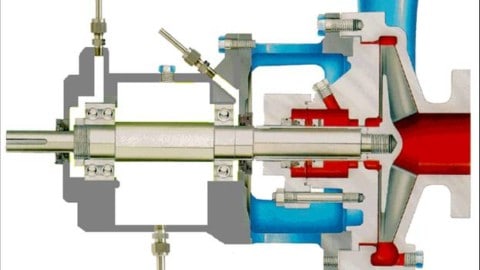Brown Brothers Engineers Australia Pty Ltd
A
Absorbed Power: The actual amount of power being consumed by the pump at a specific flow and head.
Adapter (or Support Head): Connects and aligns the power (bearing) end of an ANSI pump to the wet end.
A.N.S.I. B73.1 Standard: American National Standards Institute. A set of specifications (envelope dimensions) for centrifugal pumps.
Absolute pressure (normally in kPaA) : Atmospheric pressure added to gauge pressure.
Affinity laws: They are used to determine changes in capacity, head and power due to changes in shaft speed. The same laws can be used to estimate changes in capacity, head and power due to changes in impeller diameter.
Air ingestion: Air is coming into the stuffing box because of a negative suction pressure.
Alignment: The centreline of the pump is perfectly aligned with the centreline of the driver (usually an electric motor).
Ambient temperature or pressure: The environmental temperature or pressure in the area where the equipment is located.
Atmospheric pressure: At sea level, atmospheric pressure 101.3 kPaA.
API Standards: Standards produced by the American Petroleum Institute for various pieces of equipment applied in the oil and gas industries. Various API codes are applicable for pumps dependent on the type of pump. Examples are API610, API685 etc.
Axial Thrust: The resultant of all axial forces (i.e. in direction of the pump shaft) acting in the pump rotor.
Axial Thrust Balancing: Methods by which the axial thrust is balanced to minimize bearing loads.
B
Back to Back Impellers: In multistage pumps, some impellers are located on the shaft facing opposite directions. This is one method of achieving axial thrust balancing.
Back plate: Used in some centrifugal pumps to position the stuffing box and provide an impeller wear surface.
Back Vane: A radial narrow vane located on the back shroud of an impeller and is designed to balance axial thrust.
Back pull out pump: A design that allows the wet end of the pump to be left on the piping yet allows the power end and adapter to be removed. A.N.S.I. pumps are designed this way.
Back to back double seal: Two mechanical seals located in a pump with the rotating seal faces in opposite directions.
Balance Holes: Holes in the back shroud of an impeller designed to balance axial thrust.
Balanced seal: A design in which the seal face closing area is reduced to lower the closing force, and reduce the heat generation between the faces.
Ball bearing: Consists of an inner race, an outer race, and a series of balls between them. Often called a precision or anti friction bearing.
Bar: Metric unit for pressure and is equal to 100 kPa.
Barrier fluid: The high-pressure fluid that is circulated between the two seals in a double mechanical seal. The fluid should enter the bottom and leave the top to prevent air pockets.
Base plate: The pump and motor are mounted on this unit.
Bearing: Supports the rotating shaft and allows it to turn with a minimum amount of friction. Could be either sleeve or anti-friction type.
Bellows: A component of a mechanical seal that can be manufactured from metal or non-metallic materials to eliminate flexing, rolling or sliding.
Belt Drive: A combination of belts and pulleys that transfers torque from the driver to the pump.
B.E.P (Best Efficiency Point): The best efficiency point on a pump curve for a specific impeller diameter. It is the point where the power coming out of the pump (water power) is the closest to the power used by the pump (absorbed power) from the driver. This is also the point where there is no radial deflection of the shaft cause by unequal hydraulic forces acting on the impeller.
Buffer fluid: The low pressure fluid that is circulated between the two mechanical seal in a tandem seal.
Buna N: Sometimes called Nitrite. A common elastomer used in the sealing of oil or water.
Bushing: A close fitting support device used to restrict flow between two liquids, thermally isolate a hot liquid, support the rotating shaft or break down pressure.
Bypass line: Used to either re-circulate fluid from the pump discharge to the stuffing box, the stuffing box to the pump suction, or the pump discharge to a lower pressure point in the system. This can also be used as a manual means of flow control.
C
Canned pump: A seal/less pump with the shaft, bearings and rotor contained in a can to prevent product leakage. These are generally limited to pumping clean lubricating liquids.
Capacity: Volumetric flow of liquid measured in, litres/sec, m3/hr etc.
Cartridge seal: A self-contained assembly containing the seal, gland, sleeve, and both stationary and rotating seal faces. Usually needs no installation measurement. Must be used in a pump with impeller clearance adjustments are made.
Cavitation: Cavities or bubbles form in the fluid low-pressure area and collapse in a higher-pressure area of the pump, causing noise, damage and a loss of capacity.
Centreline design: The pump is mounted to the base plate by feet attached to the sides of the volute instead of the bottom. These are used in higher temperature pumping applications e.g. API applications and allows thermal expansion to occur in without the necessity of re alignment.
Centipoise: One unit for dynamic viscosity of a liquid.
Centistoke: One unit for the kinematic viscosity of a liquid. Dynamic viscosity divided by the liquid specific gravity at the same temperature gives kinematic viscosity.
Centrifugal pump: A pump that imparts energy to a liquid with centrifugal force.
Centrifugal separator (or cyclone separator): Equipment that utilises centrifugal force to separate solids out of the fluid. In pumping, they are used in seal flush lines.
Change of state: This defines a change in phase for any material e.g. liquid to vapour, liquid to solid, solid to vapour.
Close-coupled: A close-coupled pump is characterised by a common or rigidly-coupled motor and pump shaft. These pumps do not have a flexible coupling. There are no pump bearings and all thrust is carried by the motor bearings.
Concentricity: When the parts share the same centerline they are concentric to each other.
Condensate: This defines the change on phase of a vapour to liquid e.g. steam to water.
Constant Level Oiler: This is used to maintain the oil level in a bearing housing to the correct level as oil is used.
Cooling jacket: Cooling jackets can be located on the pump casings and /or the stuffing box of the pump to control the temperature of the fluid. Cooling jackets can be part of the component casting or separate bolt on items.
Corrosion: This is a chemical or electrochemical reaction on material surfaces that changes the profile and/or composition of the surface.
Corrosion resistant: An arbitrary term that indicates a corrosion rate of less than 0.05 mm per year.
Coupling: This is used to connect the pump to the driver. It transmits torque between the driver and pump. It can be a flexible coupling that allows some axial and radial misalignment or rigid which does not allow for any misalignment. Allowable misalignment is determined by manufacturers of the coupling.
Critical speed: Any object made of an elastic material has a natural period of vibration. When a pump rotor or shaft rotates at any speed corresponding to its natural frequency, minor unbalances will be magnified. These speeds are called the critical speeds.
Cryogenic Pumping: This generally refers to pumping liquid gases at very cold temperatures.
Cutwater: A part of the pump casing that directs the pumped liquid to the pump discharge.
D
D.I.N. standard: This is a German standard that defines various industrial products.
Deflection: Movement or displacement of the shaft in a radial direction.
Density: Measured in kg/m3 or lb/in 2. This is the ratio of the mass of a liquid in a given volume to the magnitude of that volume. Refer to Specific Gravity.
Design Duty Point: This is generally defined for a pump as a capacity at a head or pressure of the liquid being pumped, ideally the design duty point on a centrifugal pump as at BEP.
Dilatant liquid: A liquid whose viscosity increases with increased shear rate e.g. agitation.
Differential Pressure: The difference between the outlet pressure and the inlet pressure. Differential pressure is sometimes called the Pump Total Differential Pressure.
Discharge Head: The outlet pressure of the pump converted to head of liquid.
Double seal: An outdated term describing two seals in a pump. The latest terminology is “dual seals”, back-to-back double seals or tandem seal. In the past the term was used to describe a higher-pressure barrier fluid between dual seals.
Double suction pump: A pump with an impeller where liquid enters the impeller on both sides. The rotor is generally (but not always) suspended between two bearings. These pumps are generally of higher capacities.
Double volute: A centrifugal pump design that incorporates two cut waters to decrease radial loads and minimise shaft deflection when the pump is operating away from the B.E.P. Lowers the efficiency of the pump and therefore seldom used on smaller size impellers.
Dry running: Operating a pump without liquid in the pump and therefore in the seal area.
Dual Seal: Two seals running in various configurations: back to back, tandem, face to face, or concentric.
Ductility: The property of a metal that allows a great deal of mechanical deformation without cracking.
E
Efficiency: In centrifugal pumps, this is the useful power in the liquid to the expended power. That is power out of the pump divided by power into the pump.
Elastomer: A rubber-like material that, when compressed and then released will basically return to its original shape in less than five seconds.
Electrolysis: A process involving chemical change caused by the passage of an electric current through a liquid.
E.P.D.M or E.P.R: Ethylene propylene rubber. This is a common elastomer used in the sealing of water based and higher pH materials. Cannot be used in petroleum products.
Erosion: This is wear caused by mechanical action of the liquid on the surface of the materials. It is obviously more prevalent if the liquid contains solids.
Eye of the impeller: The center of the impeller where the fluid enters.
F
Face combination: The materials chosen for the two lapped seal faces. An example is carbon graphite running on silicon carbide.
Face-to-face seals: Two seals running against a common seal face. The barrier fluid pressure is always lower than stuffing box pressure.
Face lubrication: The fluid or vapor that exists between lapped mechanical seal faces.
Face pressure: The sum of all the loads on the seal face including the spring load, hydraulic load and shaft axial thrust, divided by the area of the seal face. This face load is reduced by friction between the sliding elastomer and the shaft or sleeve.
Flashing: A rapid change in phase from a liquid to a gas.
Flooded suction: This refers to a situation where the liquid level on the suction side of a pump is higher than the pump centerline and the liquid flows to the pump by gravity.
Fluorocarbon: This is a genetic term for an elastomer of which Viton (a Dupont product) is a typical example. The material has good compatibility with hydrocarbons, has high temperature capability but poor mechanical life.
Flush: Putting an outside liquid into the stuffing box of the pump at a pressure higher than stuffing box pressure. All of this liquid mixes with and dilutes the pumped fluid.
Foot Valve: A type of check valve with a built-in strainer. Used at the point of the liquid intake to retain liquid in the system, preventing the loss of prime when the liquid level is below the pump centreline.
Free length: The uncompressed axial length of a seal.
Friction Head: This is the head loss due to friction as liquid flows in pipes and fittings.
G
Gasket: This is used between two static surfaces to provide a seal. Made from a variety of deformable materials.
Gland: The part that holds one half of the mechanical seal and attaches to the stuffing box.
H
Hard face: A seal face either rotating or stationary. The most common materials are silicone carbide, ceramic, tungsten carbide, Stellite, Ni-resist. The hard face must be the wider seal face.
Hastelloy “C” (also known as Alloy C): A nickel-rich, corrosion-resistant and very hard alloy.
Head: The equivalent height of the liquid that will produce a particular pressure. Can be calculated from H (metres)= pressure in kPa/(9.8 x specific gravity).
Horizontally Split Pump: This is a pump where the casing is split into two sections in the axial plane. This means there is a top and bottom-half casing. Connections are normally on the bottom-half casing to allow removal of the top casing for pump inspection without needing to disconnect pipework.
Hydraulic balance: A method of reducing mechanical seal face loading by reducing the seal face closing area.
Hydrocarbon: A petroleum product consisting of hydrogen and carbon.
I
I.D.: Inside diameter.
I.S.O.: International Standards Organization. Sets pump and seal standards for the metric community.
Impeller: The rotating component of a centrifugal pump that imparts energy to the fluid being pumped. Available in open, semi-open and closed design.
Impeller eye: The centre of the impeller or the point where fluid enters the impeller.
Impeller shroud: The plates located on one or both sides of the impeller vanes. Prevents solids from penetrating behind the vanes.
Impeller vane: Located between the eye and the discharge side of the impeller. Directs the flow of the liquid to the outside diameter of the impeller.
Inducer: A small axial flow vane that attaches to the impeller of a centrifugal pump that reduces the N.P.S.H. required by a pump. This improvement occurs across a narrow capacity range and the impact can be detrimental outside of this range.
Induction motor: The most common type used in industry. Has a slippage of 2 to 5 percent compared to synchronous motors.
Inline pump: Mounted in the piping generally between two flanges. No base plate or alignment required.
J
Jacket: Usually refers to the heating/cooling jacket surrounding the stuffing box on some pumps.
K
Kalrez®: An “elastomer-like” material manufactured by E.I. Dupont that is used to seal most solvents and other aggressive fluids. It is available in several different grades.
Kilowatt: One thousand watts. The normal unit for power in the metric system.
Kpa (kilopascals): A metric unit of pressure.
L-Z Glossary of pump terms here















